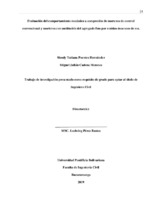Mostrar el registro sencillo del ítem
Evaluación del comportamiento mecánico a compresión de morteros de control convencional y morteros con sustitución del agregado fino por residuo óseo seco de res
| dc.contributor.advisor | Pérez Bustos, Ludwing | |
| dc.contributor.author | Puentes Hernández, Slendy Tatiana | |
| dc.contributor.author | Cadena Meneses, Miguel Julián | |
| dc.coverage.temporal | 2020 | |
| dc.date.accessioned | 2021-05-27T18:31:33Z | |
| dc.date.available | 2021-05-27T18:31:33Z | |
| dc.date.issued | 2020 | |
| dc.identifier.uri | http://hdl.handle.net/20.500.11912/8623 | |
| dc.description | 153 páginas | spa |
| dc.description.abstract | Actualmente en la industria de la construcción se genera una cantidad notable de residuos, que ocasiona un impacto ambiental negativo; estos residuos son generados para suplir las necesidades técnicas en la construcción. Debido al impacto ocasionado, se busca remplazar e innovar en nuevos materiales para la construcción, con el fin de ahorrar materias primas, por esta razón se implementó los residuos óseos de res; ya que es un material fácil de adquirir a bajo costo, para la realización de una mezcla de mortero alternativo. Por ende, se procedió hacer ensayos preliminares en el laboratorio, adicionándole el hueso de res a los diseños de mezclas de modero, con el fin de comparar la resistencia entre un mortero convencional y un mortero con porcentaje de hueso de res. En primer lugar, para el análisis del comportamiento mecánico de mortero con agregado de hueso de res, inicialmente se seleccionó adecuadamente el material a trabajar, exponiéndolo térmicamente mediante el sof, una vez obtenido el hueso seleccionado se trabajó en la caracterización mediante ensayos de laboratorio de dicho material, así como los componentes que definen el mortero (arena, agua y cemento). Después de haberse caracterizado los materiales, se procedió hacer el diseño de mezclas con diferentes porcentajes de hueso de res para los cubos de morteros. Luego se fallaron los cubos de morteros a los 7, 14 y 28 días. Gracias a los resultados obtenidos, se escogieron las cantidades de porcentajes del 15% y 10% de residuo óseo; tomados del tamiz pasa n° 4 retenido % considerando la arena más gruesa entre 2 y 5 mm. Se determinó que los morteros a base de hueso de res reducen el peso ligeramente comparados con el mortero convencional analizado. | spa |
| dc.description.abstract | Currently, a significant amount of waste is generated in the construction industry, which causes a negative environmental impact; these wastes are generated to meet the technical needs in construction. Due to the impact caused, it is sought to replace and innovate in new construction materials, in order to save raw materials, for this reason beef bone waste was implemented; because it is an easy material to acquire at low cost, for the realization of an alternative mortar mixture. Therefore, preliminary tests were carried out in the laboratory, adding the beef bone to the mortar mix designs, in order to compare the resistance between a conventional mortar and a mortar with percentage of beef bone. In the first place, for the analysis of the mechanical behavior of mortar with aggregate of beef bone, the material to work was initially properly selected, exposing it thermally to the sun for a considerable time, once obtained the selected bone, it was worked on the characterization by means of laboratory tests of said material, as well as the components that define the mortar (sand, water and cement). After having characterized the materials, we proceeded to design mixtures with different percentages of beef bone for the mortar cubes. Then the mortar cubes were failed at 7, 14 and 28 days. Thanks to the results obtained, the amounts of percentages of 15% and 10% of bone residue were chosen; taken from the sieve passes n ° 4 retained 3/4 considering the thickest sand between 2 and 5 mm. It was determined that beef bone-based mortars reduce the weight slightly compared to the conventional mortar analyzed | eng |
| dc.format.mimetype | application/pdf | |
| dc.language.iso | spa | |
| dc.publisher | Universidad Pontificia Bolivariana | spa |
| dc.rights | Attribution-NonCommercial-NoDerivatives 4.0 International | * |
| dc.rights.uri | http://creativecommons.org/licenses/by-nc-nd/4.0/ | * |
| dc.subject | Argamasa | spa |
| dc.subject | Resistencia a la compresión | spa |
| dc.subject | Tejido óseo - Res | spa |
| dc.subject | Durabilidad | spa |
| dc.subject | Material orgánico | spa |
| dc.title | Evaluación del comportamiento mecánico a compresión de morteros de control convencional y morteros con sustitución del agregado fino por residuo óseo seco de res | spa |
| dc.type | Trabajo de grado | spa |
| dc.publisher.department | Escuela de Ingenierías | spa |
| dc.publisher.program | Ingeniería Civil | spa |
| dc.type.hasVersion | publishedVersion | spa |
| dc.description.sectional | Bucaramanga | spa |
| dc.description.degreename | Ingeniero Civil | spa |
Ficheros en el ítem
Este ítem aparece en la(s) siguiente(s) colección(ones)
-
Trabajos de grado [6698]
Monografías, artículos, informes, proyecto de grado


